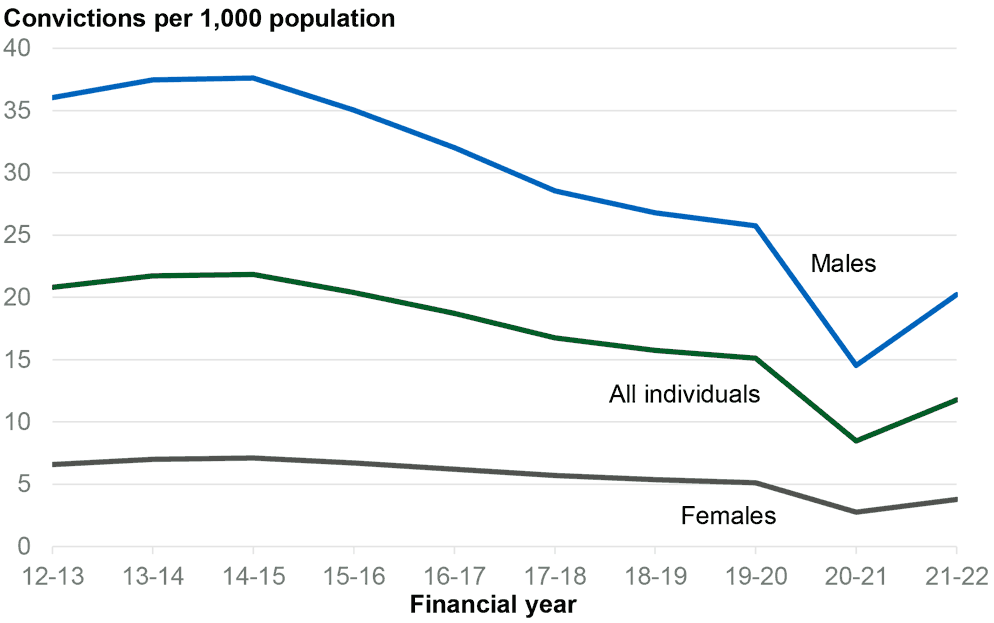Criminal Proceedings in Scotland, 2021-22
Statistics on criminal proceedings concluded in Scottish courts and alternative measures to prosecution issued by the police and the Crown Office and Procurator Fiscal Service are presented for the 10 years from 2012-13 to 2021-22. The latest two years of data were impacted by the COVID-19 pandemic.
14. Age and sex
(Tables 4a-c, 5a-b, and 10)
Sex in this bulletin is generally based on how a person presents, unless an alternative gender is disclosed. Sex may be different to that recorded at birth, for example where a Gender Recognition Certificate is provided. In a small number of records sex will be recorded as unknown if a clear understanding of the sex of the individual is not known. See Annex D for further details.
In 2021-22 there were 12 convictions per 1,000 population. There were more convictions for males at 20 convictions per 1,000 population compared to four for females.
The overall number of convictions per 1,000 population has declined over the most recent 10 years from 21 convictions per 1,000 population in 2012-13. The decline has primarily been driven by a decrease for males, down from 36 convictions per 1,000 population in 2012-13 to 20 in 2021-22. The number for females has been consistently much lower than for males, but also shows an overall decline, from seven to three convictions per 1,000 population between 2012-13 and 2021-22 (Chart 12).

Over the past 10 years, the gap between the number of convictions per 1,000 population for younger people compared to older people has become smaller. This has been driven by a fall in the number of convictions per 1,000 population for younger people, especially younger men. For people aged 31 to 40 and 41 to 50, the number has been on a more gradual downward trend over the last decade.
In 2012-13, the age group with the highest numbers of convictions per 1,000 population was those aged 21 to 30, with 51 convictions per 1,000 population. In 2021-22, the highest number of convictions per 1,000 population was for the 31 to 40 age group overall (26 per 1,000), the 21 to 30 age group also showing a similar 24 convictions per 1,000 population.
Convictions by sex, age and crime type
Males accounted for 83% of all convictions in 2021-22, a similar proportion as each year in the past 10 years (range 82% to 84%). More males than females were convicted in all crime and offence categories.
Whilst females accounted for 17% of all convictions, they accounted for relatively higher proportions of convictions for the following crime types in 2021-22:
- Shoplifting, 30% or 798 of all convictions;
- Fraud, 29% or 68 of all convictions;
- Other crimes against society, 30% or 21 of all convictions; and
- Wildlife offences, 35% or 50 of all convictions.
People under 21 accounted for 6% of all convictions in 2021-22, but this was proportionally higher for Serious assault and attempted murder (13%), Theft of a motor vehicle (15%) and Vandalism (13%). By contrast, those over 40 accounted for 32% of all convictions, making up a higher proportion of convictions for Sexual assault (60%), Crimes associated with prostitution (88%) and Urinating etc. (67%).
Sentencing by sex and age
Overall, males are more likely to receive a custodial sentence than females. This is illustrated by males accounting for 83% of all people convicted in 2021-22 but representing a higher proportion of all custodial sentences (94%). Females were more likely to be issued with an “Other sentence” (which are mostly admonishments) with 27% of these types of punishments having been given to females compared to the 17% of all convictions that females represent (Chart 13).
Please note that sentencing decisions are reflective of a number of factors such as the severity of the crime and whether the individual has offended in the past. In addition, the decision on what type of punishment is reasonable will be based on the personal circumstances of the offender. These statistics do not take account of these factors. The Reconviction Rates in Scotland National Statistics present analyses on the last sentence received in a financial year, by the number and type of previous crimes and sentences.

Contact
Email: Justice_Analysts@gov.scot
There is a problem
Thanks for your feedback